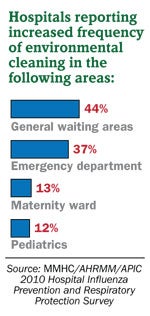Survey finds cleaning routines increased markedly during H1N1 epidemic
Approximately 44 percent of U.S. hospitals increased cleaning frequencies in general waiting areas as a result of the H1N1 flu epidemic last year, according to a survey conducted by Health Facilities Management's sister publication Materials Management in Health Care, along with the Association for Healthcare Resource & Materials Management and the Association for Professionals in Infection Control and Epidemiology.
Thirty-seven percent of respondents also increased emergency department cleaning frequencies, while 13 percent and 12 percent increased frequencies in maternity wards and pediatric units, respectively.
The "Hospital Influenza Prevention and Respiratory Protection Survey" contacted a random sample of 8,609 hospital vice presidents and directors of materials management, directors of infection prevention and infection control managers to find out about the strategies hospitals used in reducing seasonal and H1N1 flu transmission among patients, visitors and workers and the challenges faced in managing supplies and staffing during the 2009-2010 winter flu season. The response rate was 12.9 percent, or  1,109 completed surveys.
1,109 completed surveys.
Among other results, the survey found that more than 91 percent of respondents protected their workplaces by asking sick employees to stay home.
Additionally, posting visual alerts at the entrance to outpatient facilities and emergency departments; offering face masks to symptomatic patients who are able to wear them; providing facial tissues, no-touch receptacles for tissue disposal and hand hygiene products in waiting areas and examination rooms; and ensuring that supplies for hand washing (i.e., soap, disposable towels) are consistently available were selected as the most frequent steps taken to protect visitors and patients coming into the health care facility.


